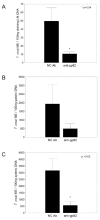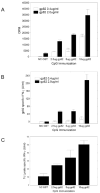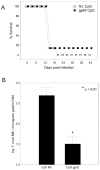Immune responses to gp82 provide protection against mucosal Trypanosoma cruzi infection
- PMID: 20835618
- PMCID: PMC3150497
- DOI: 10.1590/s0074-02762010000500015
Immune responses to gp82 provide protection against mucosal Trypanosoma cruzi infection
Abstract
The potential use of the Trypanosoma cruzi metacyclic trypomastigote (MT) stage-specific molecule glycoprotein-82 (gp82) as a vaccine target has not been fully explored. We show that the opsonization of T. cruzi MT with gp82-specific antibody prior to mucosal challenge significantly reduces parasite infectivity. In addition, we investigated the immune responses as well as the systemic and mucosal protective immunity induced by intranasal CpG-adjuvanted gp82 vaccination. Spleen cells from mice immunized with CpG-gp82 proliferated and secreted IFN-γ in a dose-dependent manner in response to in vitro stimulation with gp82 and parasite lysate. More importantly, these CpG-gp82-immunized mice were significantly protected from a biologically relevant oral parasite challenge.
Figures



References
-
- The T cruzi Proteome database [database on the internet] Athens (GA): 2007. [January 2010]. The T. cruzi Proteome. Available from http://kiwi.rcr.uga.edu/tcprot/
-
- Alarcon DN, Diaz-Bello Z, Colmenares C, Ruiz-Guevara R, Mauriello L, Zavala-Jaspe R, Suarez JA, Abate T, Naranjo L, Paiva M, Rivas L, Castro J, Marques J, Mendoza I, Acquatella H, Torres J, Noya O. Large urban outbreak of orally acquired acute chagas disease at a school in caracas, Venezuela. J Infect Dis. 2010;201:1308–1315. - PubMed
-
- Araujo AF, de Alencar BC, Vasconcelos JR, Hiyane MI, Marinho CR, Penido ML, Boscardin SB, Hoft DF, Gazzinelli RT, Rodrigues MM. CD8+-T-cell-dependent control of Trypanosoma cruzi infection in a highly susceptible mouse strain after immunization with recombinant proteins based on amastigote surface protein 2. Infect Immun. 2005;73:6017–6025. - PMC - PubMed
-
- Atwood JA, III, Weatherly DB, Minning TA, Bundy B, Cavola C, Opperdoes FR, Orlando R, Tarleton RL. The Trypanosoma cruzi proteome. Science. 2005;309:473–476. - PubMed
-
- Basombrio MA, Segura MA, Mora MC, Gomez L. Field trial of vaccination against American trypanosomiasis (Chagas’ disease) in dogs. Am J Trop Med Hyg. 1993;49:143–151. - PubMed
Publication types
MeSH terms
Substances
Grants and funding
LinkOut - more resources
Full Text Sources
Medical

